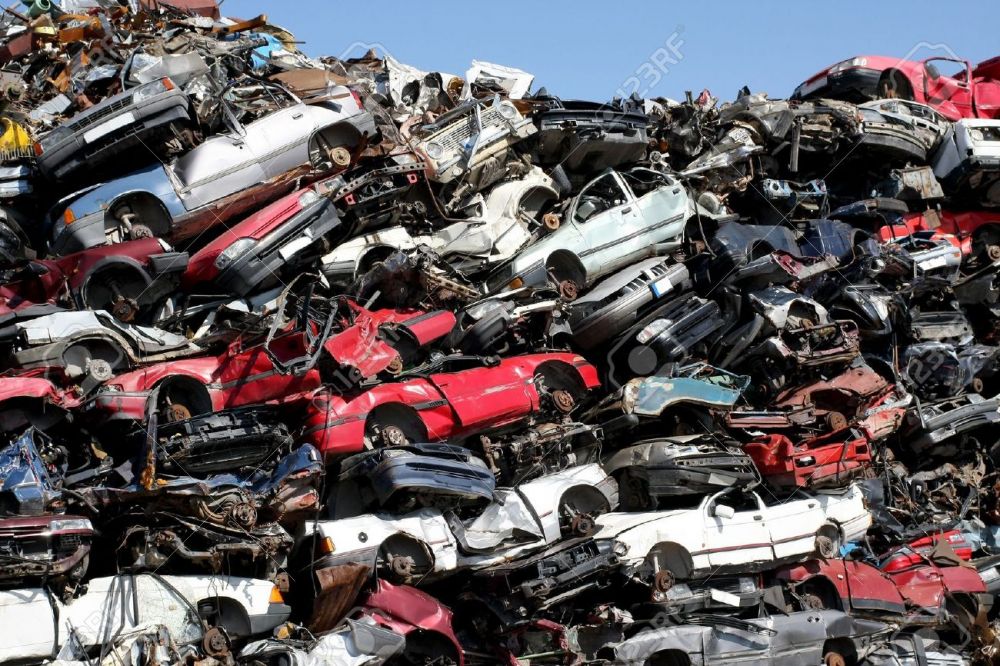When cars are recycled they are first "crushed" by junkyards for ease of transport. The junkyards are responsible for removing gas tanks and automotive fluids. However, as you can imagine, policing these requirements is nearly impossible. If you have ever seen a crusher in action you will notice a pool of fluids collected in the crusher bed. Even if the cars have been properly prepared, residual fluids coating hoses, tubes, lines, pans, sumps and reservoirs are always present in the crushed stock. The compacted blocks are then shipped to the recycler (John Ross is the only recycler in N.S.) The stock goes through a hammer mill, breaking it into 10cm pieces. These pieces then go through a series of separation procedures to isolate re-sellable products. About 70% of the vehicle is recycled; the other 30% is shipped to landfills as ASR.
The unrecyclable bits include cushion foam, rubber parts, vinyl, plastic, paint, etc. This material is of course, coated with the residual hydrocarbon fluids previously mentioned, including engine oil, anti-freeze, brake fluid, transmission oil, hydraulic fluid, crankcase oil and others. In addition, significant amounts of mercury are present in the fluff, as there is no requirement in N.S. (as there is in many other jurisdictions) to remove the automotive switches that contain this extremely toxic element. NSECC seems reluctant to call this material hazardous or toxic waste although most jurisdictions classify ASR this way. Industry publications are clear on this point. ASR is a toxic carcinogen with hazardous levels of TCLP (toxic characteristic leaching procedure, tests mandated by EPA for most dangerous elements) metals and PCBs. ASR leachate is also highly environmentally mobile, and a known agent of spontaneous combustion.
Yes, this ASR material has been tested by John Ross. Oddly, the tests were carried out in North Carolina, not in N.S. We obtained the results by foipop request. There were two reports. The original showed levels of TCLP metals and PCBs far in excess of acceptable Canadian standards, even industrial standards. The second report advised, in small print, that test results for TCLP metals, PCBs and moisture content had been removed from the original report at the request of John Ross. This second report is apparently the analysis accepted by NSECC, since they claim that all tests showed toxins in ASR to be "well below" Canadian standards. The report described the test sample as "cushion foam and paint chips," suggesting that John Ross may have "adjusted" the contents of the sample. Indeed, the test company cited evidence of "matrix interference," which we assume confirms the selective content of the sample.
It should be noted that while NSECC has admitted that ASR should not be disposed of in a generation one (unlined) landfill, the department has approved a mixture of ASR and common C&D materials as an acceptable "intermediate" cover for all landfills. We think that ASR by any other name is still ASR.
It is obvious what has been going on at Arlington. John Ross has to get rid of a large amount of ASR. So Ross makes a deal with a profit-minded dump owner, to dispose of the stuff in a rural gen.one facility with no oversight. NSECC helps out by looking the other way. Everybody stuffs their pockets and hides the records of transactions. The arrangement was so profitable that Ross could afford to ship the material 175k, from Dartmouth to Arlington, just to get rid of it. However the long and loud complaints of Andy George and the Annapolis Waterkeepers eventually forced NSECC to ban the disposal of raw fluff in gen. one facilities, throwing a wrench into the scheme.. NSECC then allowed Ross to make an end run around the new regulation by approving "manufactured cover material" (ASR mixed with C&D) for use in all landfills.
We have established pristine background domestic water quality in our community. However, the extensive testing required to identify all potential toxins from Arlington is financially prohibitive. We have asked NSECC to create a comprehensive, ongoing water sampling regime for our domestic water supplies, but they disavow responsibility for testing water beyond dump boundaries. However, one official test was performed (mistakenly) in 2018 on land hundreds of meters beyond dump property. It showed toxic levels of Ammonia, Benzene, hydrocarbon contaminants, and at least eight heavy metals. The department shrugged away the significance of the tests by attributing the results to an "exceedance" event caused by water used to douse a 2018 fire. However, monitoring well tests from dump property obtained by FOIPOP showed the same levels of contamination long before the fire.
It is a long story; if you want more info, let us know.
Kip McCurdy



No comments:
Post a Comment